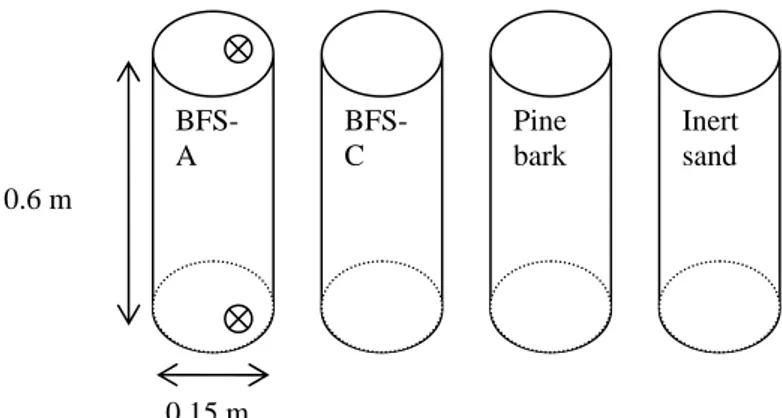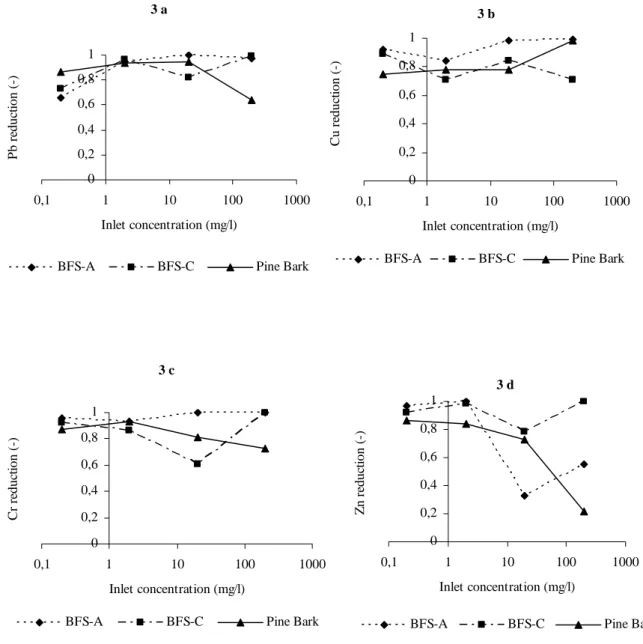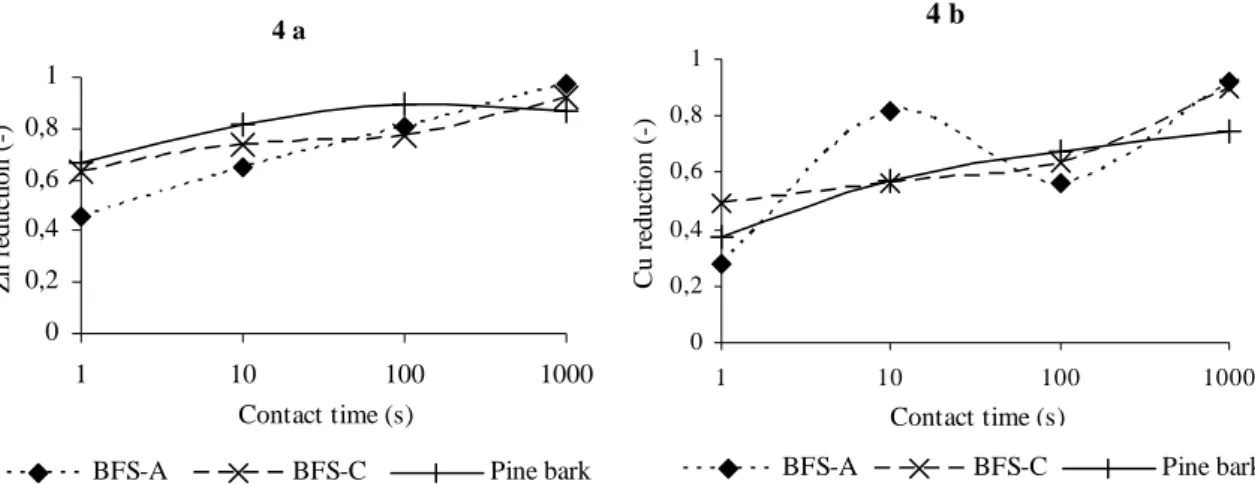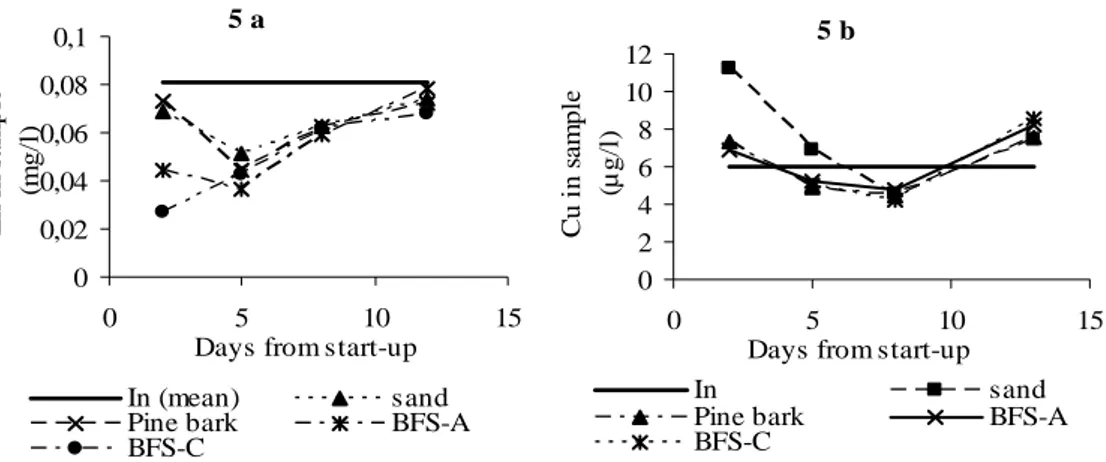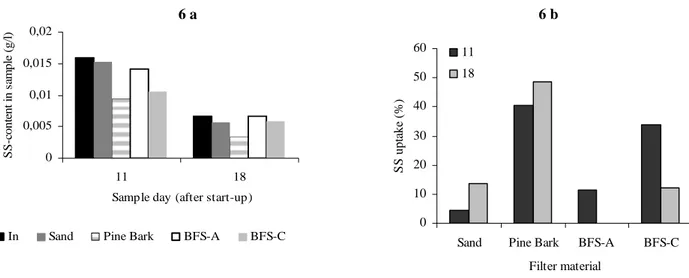TREATMENT OF LANDFILL LEACHATE
USING FILTER SUBSTRATES
E. NEHRENHEIM*, L. JOHANSSON WESTHOLM* AND S. WAARA*
*MDH, Department of Public Technology, Mälardalen University, Västerås,
Sweden
SUMMARY: Three by-products from the steel and paper manufacturing industries have been tested as filter materials for removal of heavy metals in metal solution and in landfill leachate. Laboratory experiments were used to determine the capacity of the materials to remove heavy metals. A column set-up at a landfill site examined the field application possibilities of pine bark, amorphous and crystalline blast furnace slag. All three materials have shown large potential for removal of heavy metals in metal solution also when the concentrations are low. On-site treatment however was distrurbed by factors not present in batch experiments. Physical parameters such as pH and electric conductivity of the water stream were not significantly affected by the treatment.
1. INTRODUCTION
Demands on treatment of landfill leachate have arisen in Sweden and in other EU member states as well as in countries overseas. There are several methods that can be used for the treatment, e.g. a variety of biological oxidation and reduction processes including the SBR technique, activated sludge and the RBC technique for instance. Most of these processes are incorporated into some kind of technical treatment facility. These have in many cases been rejected since they are far too complicated and expensive to use for landfill operators which run small landfills. These landfill operators have been forced to seek for alternative solutions, e.g. small-scale solutions based on natural treatment methods. Constructed wetland systems (CWS) is one feasible option for treatment of landfill leachate and several Swedish landfill operators have in recent years adopted this solution (Johansson Westholm, 2003, 2004). Another treatment method that has attracted attention is the filter technique. This technique is based on passage of a polluted water stream through a filter material, or substrate, which can be placed in special modules or be incorporated in a CWS for instance. The filter material, or combination of materials, must have demonstrated a high capacity to retain the pollutant(s) to be removed from the landfill leachate.
Laboratory investigations of reactive filter materials have shown that pine bark and blast furnace slag (BFS), by-products from the paper and steel manufacturing industries; are effective for sorption of heavy metals from heavy metal solutions (Dimitrova and Mehanjiev, 1998, 2000, Dimitrova, 2002, Al-Asheh and Duvnjak, 1998). BFS has in a number of different experiments (batch, column) also demonstrated a high capacity to sorb phosphorus (P) (Johansson, 1998). Still up to today there have been few field studies assessing the potential metal reduction from landfill leachate by filter materials. However, iron has been shown to be removed to 90 % by limestone filters (Aziz et al., 2003).
2. MATERIALS AND METHODS2.1 Description of the Lilla Nyby landfill site
The landfill site Lilla Nyby is situated in the town of Eskilstuna, 100 km West of Stockholm. The landfill covers an area of approximately 35 ha and it has been in operation since the middle of the 1950’s and has since then received domestic and industrial wastes. Since 2002 the main leachate stream from the landfill is treated in an ammonium stripping system. A minor leachate stream is formed on the western part of the landfill and it is neither cost nor environmentally effective to treat it in the ammonium stripping system. The weak stream would only cause a dilution of the leachate resulting in a lower ammonium stripping efficiency. In the end of 2004, the landfill operator decided to test the filter technique since it was regarded as the best option available.
2.2 Characteristics of the landfill leachate
The characteristics of the landfill leachate to be treated was very scarce, it was however assumed that it would be a weak leachate. In order to get a more complete characterization of the leachate, the first phase of the investigation was to screen it to learn more about its characteristics. The screening started in December 2004 and sampling campaigns were carried out every month. At each sampling occasion, three samples of 1000 ml and two of 250 ml were sampled in plastic bottles. The samples were sent to the laboratory right after the sampling. The leachate was analyzed for a series of metals, nutrients (tot-P, tot-N, NH4+ and NO3-), physical parameters (pH, electric conductivity), BOD, COD and suspended solids (SS). Organic pollutants and BTEX were sampled in glass bottles at twice and sent to laboratory. In the present paper, only some parameters, e.g. metals, SS and pH, will be discussed. The method used for sampling and analysis were the same as described by Waara et al. (2003).
2.3 Materials
The BFS used in this study is a by-product from the steel manufacturing industry. The slag was supplied by SSAB Merox AB. Two kinds of BFS were tested in the study, amorphous slag (BFS-A) and crystalline slag (BFS-C). They had the same composition but differed in structure due to the cooling processes rendering the BFS-A less porous than the BFS-C. The amorphous slag had a particle size of 2-4 mm and the corresponding particle size of the crystalline slag was 4 mm.
The pine bark tested is a commercial product made from a by-product from the pulp and paper industry. It consists of dried and granulated pine bark to 85-90 % and wood fiber 10-15 %. The particle size of pine bark is roughly between 1-15 mm.
Inert sand (particle size 2 mm) was used as a reference filter material. The sand was assumed to have neither reactive properties nor micro pores thus the only mean of retention of metals in the material should be by mechanical separation.
2.4 Methods
2.4.1 Batch experiments
To determine the capacity for the materials used in the pilot study to sorb metals under optimized conditions, a laboratory experiment was conducted as a batch test. Four multi-solutions were prepared with 0.2, 2, 20 and 200 mg/lof Zn (Zn(NO3)26H2O),
Pb (N2O6Pb), Cu (Cu(NO3)23H2O) and Cr (Cr(NO3)29H2O). 10 g of BFS-A and BFS-C and 5 g of pine bark were shaken with 50 ml of each multi-solution for 30 minutes at room
temperature. The lower weight of pine bark was chosen due to the significantly lower density which would require a larger filter container per mass filter material in a full scale application. The volume of 5 g of pine bark is comparable to the volume of 10 g of BFS.
Since one of the aims of the pilot study also was to see investigate the relevance of the contact time between the material and the metal solution for the sorption capacity another batch test was carried out. The metal solution with the lowest concentration (0.2 mg/l) was shaken as in the previous test but for 1, 10, 100 and 1000 seconds, respectively.
The solutions were then analyzed for the metals by means of atomic absorption spectrometry (AAS) with AAS Vario 6 instrument, using flame technique in accordance to Swedish Standard (SS028150). The lower detection limits for the flame were for Zn; 0.0014 mg/l, Pb; 0.013 mg/l, Cu; 0.003 mg/l and Cr; 0.0054 mg/l, respectively
2.4.2 On-site column experiments
At the landfill in Eskilstuna a field study in forms of four columns (Ø 0.15 m, h 0.6 m) was installed. Each column was filled with either BFS-A, BFS-C, pine bark or inert sand (see Figure 1). The leachate stream to be treated was lead to a well from where it was pumped into a container placed in a pump house at the site. A volumetric pump supplied each column with leachate (1 l/min) from the container. The flow was chosen to be rather high in order to decrease the risk of clogging inside the columns due to the strong streamline forces. Experimental set-up was conducted to investigate if the materials could sorb metals even at high volumetric load. The water flow was in an upward direction keeping the filter materials constantly saturated.
The column experiment was run for two months during the spring of 2005. Twice a week, two replicate samples were taken from the inlet to the columns and from the outlet of each column. Sampling and preservation at the site were conducted according to ISO-standard (5667-3:1994). The samples were analyzed for the same parameters as in the screening of the leachate, but metals of special concern in the column experiment were cupper (Cu), lead (Pb), nickel (Ni) and zinc (Zn). These heavy metals were chosen based on the results from the screening since they occurred in relatively high concentrations. Metal analysis was conducted as above. pH and electric conductivity were analyzed according to Swedish Standard (SS 028148) and ISO standard (7888:1985), respectively. SS was analyzed twice during the study to investigate the risk of clogging and was conducted according to European Standard (EN 872:1996). The solutions were then analyzed for the metals by means of atomic absorption spectrometry (AAS) with AAS Vario 6 instrument, using graphic furnace technique in accordance to Swedish Standard (SS028183). The lower detection limits for the flame were for Zn; 0.003 µg/l, Pb; 0.08 µg/l, Cu; 0.19 µg/l and Ni; 0.3µg/l, respectively
Figure 1. Principle of column set up at the landfill site.
0.15 m 0.6 m BFS-A Pine bark Inert sand BFS-C Sample
3. RESULTS AND DISCUSSION 3.1 Screening
The results of some metals from the screening are shown in Figure 2.
2 a 0 2 4 6 8 10 2004-11-09 2004-12-29 2005-02-17 2005-04-08 Sample date P b co n c en tr at io n ( µ g /l ) 2 b 0 5 10 15 20 25 30 35 2004-11-09 2004-12-29 2005-02-17 2005-04-08 Sample date C u c onc e n tr a ti on (µ g/ l) 2 c 0 50 100 150 200 250 300 2004-11-09 2004-12-29 2005-02-17 2005-04-08 sample date Z n c onc e n tr a ti on ( µ g/ l) Dissolved T otal 2 d 0 5 10 15 20 2004-11-09 2004-12-29 2005-02-17 2005-04-08 Sample date N i c onc e n tr a ti on (µ g/ l)
Figure 2. The content of Pb (2 a), Cu (2 b), Zn (2 c) and Ni (2 d) landfill leachate in one sample a month over four months.
Table 1 – Results from screening of the landfill leachate
Mean (min - max) Swedish mean (min - max)1
Zn (µg/l) 123 (36 - 264) 63 (16 - 340) Cr (µg/l) 1.6 (0.1 - 2.7) 17 (1.5 - 45) Cu (µg/l) 18 (6.1 - 33) 22 (9.8 - 80) Pb (µg/l) 2.8 (0 - 8.1) 4.9 (0 - 4.9) Ni (µg/l) 12 (4.7 - 16) 30 (9.8 - 91) 1 (Öman et al, 2000)
The pH in the landfill leachate was during the period around 7.3 (± 0.1). The alkalinity varied between 280-870 mg/l. Electric conductivity varied between 60-160 mS/m during the sampling period and SS varied during the period from 0.007-0.19 g/l. Other parameters that might be of
interest in the leachate were tot-N (14 ± 8 mg/l ), N-NH4+ (7 ± 6 mg/l) and COD (192 ± 224 mg/l).
Also the metal content varied during the sampling period. The variations in the metal content in the leachate during the screening period are illustrated in Figure 2. The metal content was high in the first sample, taken in December 2004 (mid winter in Sweden) but decreased then for Pb, Cu and Zn. Ni however seems to just drop at one sample point and increases again in the leachate. The results of some total concentrations of interesting metals from the screening are presented in Table 1 together with data from untreated leachates from 14 Swedish landfill sites. The mean values from the screening were below the Swedish mean for all metals except Zn which is twice as high. The largest measured value from the screening was higher than the Swedish mean for Cu and Pb. It appears that Pb, Zn, Cu and Cr occurs mainly in dissolved forms in the leachate (see Figure 2).
3.2 Batch experiments
3.2.1 Metal uptake under optimized conditions
Figure 3 shows the metal sorption to the materials from the batch experiment. Under optimized conditions all sorption processes are active. Sorption is a wide term including ion and ligand exchange as well as complex binding on particle surface (adsorption) and inside the micro pores due to diffusion. A part from sorption precipitation reduces some metals from the solution. Shaking the solution with BFS-A gave a rather similar result for Cu and Cr. Cr was sorbed very efficient to BFS-A (> 90 %). Lead was sorbed to a lower extent at low concentrations but very efficiently at concentrations of 2 mg/l and above. For Zn there was a significant decrease in sorption capacity at the concentration of 20 mg/l which was the concentration where the other metals appear to be sorbed most efficiently. This could be explained by some kind of competition of the surface sites between the metals in the solution.
Sorption to BFS-C was also limited at the concentration of 20 mg/l but Zn was not the only metal that suffered from this. Both Zn and Cr were significantly less sorbed at this concentration (expressed as percentage) to the advantage of Cu which had the best up-take rate at the 20 mg/l concentration. For the same volume of BFS-C (but half the mass) the reduction capacity was above 80 % throughout the entire initial concentration span.
Pine bark sorbed Cu best at the 200 mg/l level. For the other metals the up-take to pine bark appeared to decrease with increasing concentration. The Zn removal by pine bark was as low as 20 % at the 200 mg/l level but also for Cr and Pb the decrease in sorption capacity at high concentrations was observed.
3 a 0 0,2 0,4 0,6 0,8 1 0,1 1 10 100 1000 Inlet concentration (mg/l) P b re duc ti on (-)
BFS-A BFS-C Pine Bark
3 b 0 0,2 0,4 0,6 0,8 1 0,1 1 10 100 1000 Inlet concentration (mg/l) Cu re duc ti on (-)
BFS-A BFS-C Pine Bark
3 c 0 0,2 0,4 0,6 0,8 1 0,1 1 10 100 1000 Inlet concentration (mg/l) Cr re duc ti on (-)
BFS-A BFS-C Pine Bark
3 d 0 0,2 0,4 0,6 0,8 1 0,1 1 10 100 1000 Inlet concentration (mg/l) Z n re duc ti on (-)
BFS-A BFS-C Pine Bark
Figure 3. Reduction capacity due to sorption to BFS-A, BFS-C and pine bark of Pb (3 a), Cu (3 b), Cr (3 c) and Zn (3 d).
When concentrations in the effluent increased and the sorption processes approached equilibrium, a competition of the sites occurred. Pb and Cu are (together with mercury) strongly adsorbing metals in soils (Gustafsson et al, 2004) while Zn, Ni and Cd are weakly absorbed. This fact could explain why Pb and Cu were sorbed to a higher extend than Zn (see Figure 3). The phenomena appeared to be more distinct for BFS-A in this study.
4 a 0 0,2 0,4 0,6 0,8 1 1 10 100 1000 Contact time (s) Z n re duc ti on (-)
BFS-A BFS-C Pine bark
4 b 0 0,2 0,4 0,6 0,8 1 1 10 100 1000 Contact time (s) Cu re du ct ion (-)
BFS-A BFS-C Pine bark
Figure 4. Sorption rate of Zn (4 a) and Cu (4 b) to BFS-A, BFS-C and pine bark at various contact times.
3.2.2 Contact time experiment
Figure 4 shows the uptake of Zn and Cu to BFS-A and BFS-C. Coefficient of variation (CV) for all replicate samples but two was below 10 %, the two exceptions were below 35 %. There was a significant increase in sorption capacity when the contact time was increased for all materials. For BFS-A this relationship was almost linear for Zn but not for Cu. Cu was sorbed to between 50 and 90 % at contact times above 10 seconds. The sorption to BFS-C was also close to linear for both metals. Pine bark showed a linear relationship up to between 100 and 1000 seconds contact time where no increase in reduction capacity was observed.
3.3 On–site column experiment 3.2.1 Metal reduction
The inlet and outlet concentrations of Zn in all columns are shown in Figure 5. CV was 10 % for all means from the replicate samples except in 3 occasions. Since the inlet concentration varied largely during the sampling period, the inlet concentration in the figure is presented as the mean of inlet concentrations and the screening.
For all filter materials the outlet concentrations appear to increase with time and after 12 days the reduction appears to be very low, close to zero if compared to the inlet concentration at the same day. Outlet concentrations of Zn from BFS-A is at the same level as the outlet concentrations from the reference material (sand) giving the assumption that no reactive properties have been active during the period. Cu was not reduced from the leachate at all during the first period of the column experiment. BFS-C shows an almost linear relationship between outlet concentration and days from start-up for Zn. BFS-C also reduced Cu to some extent. This material also showed the highest sorption capacity in the beginning of the study.
Pine bark has a rather similar pattern as the BFS-C for Zn removal but is not as effective in the beginning. Pb in the landfill leachate was under detection limit during the columns studies.
A pilot study similar to the present was carried out by Färm (2002). Opoka, pine bark and a mixure of opoka and zeolite were tested for metal uptake in storm water run-off. In this experiment, Zn and Cu was reduced to somewhere between 20-90 % in all samling points. The Zn concentration in the storm water was below the corresponding concentration in the leachate while Pb, Cu and Cr were slightly higher. The inlet flow was lower (0.02 l/min) which could have had a positive effect on the reduction capacity.
5 a 0 0,02 0,04 0,06 0,08 0,1 0 5 10 15
Days from start-up
Zn i n s a m p le (m g /l ) In (mean) sand
Pine bark BFS-A
BFS-C 5 b 0 2 4 6 8 10 12 0 5 10 15
Days from start-up
Cu i n s a m p le (µ g/l) In sand
Pine bark BFS-A
BFS-C
Figure 5. Inlet and outlet concentration of Zn (5 a) and Cu (5 b) in the on-site column experiment
Giving a 1 l/min flow the contact time between the material and each water unit is approximately 600 seconds. At this level, sorption occurs to 90 % in the batch experiments. Comparisons between contact times in column studies and batch experiments might be uncertain since the sorption mechanisms might be affected by the behaviour of the water. In a batch experiment a turbulent flow around the particles is created, offering an optimum contact with all the particle sites. In the almost laminar flow inside a column there are distances between some of the contaminants and the surface sites and the natural way for the solutes might be to follow the water stream line. This is probably also affected by the SS occupation of sites discussed in the following chapter. Preferential flows might also be the reason for the low reduction.
3.2.2 SS
The uptake of SS is shown in Figure 6. The sand column reduced 4.4 % (CV = 14 %) and 13.6 % (CV = 33 %), respectively. BFS-A reduced 11 % (CV = 0.09 %) of the SS the first sample day (march 11th) and close to 0 % in the second sample day (March 18th). This implies that clogging phenomena might have been avoided in this column. In the column filled with BFS-C SS was reduced to 34 % (CV = 1 %) on the first sample day and 12 % (CV = 18 %) on the second. In the column filled with pine bark the up-take of SS was higher than in the other columns, between 41 % (CV = 0 %) and 48 % (CV = 8 %), respectively. This implies than the risk of clogging in this column would be higher. The up-take of particle bound metals can however be higher in this column and thereby, if the rate of dissolved metals is low, result in a high metal-uptake.
In field studies testing the capability to remove P from waste water (Nehrenheim, 2004, unpublished data) the uptake of SS was shown to be significant for the P-reduction. The mechanism of interest was believed to be a surface of organic material covering the micro pores and thereby leaving a significantly smaller particle surface for the ion-exchange and complex bindings to occur at. The high SS-uptake and extremely low metal uptake to pine bark might to some extent origin from this reason. BFS-C reduced SS to a rather high extent compared to pine bark. The micro-porosity of BFS-C is however very high which might prolong the period before the pores are blocked.
0 10 20 30 40 50 60
Sand Pine Bark BFS-A BFS-C Filter material S S u p tak e (% ) 11 18
Figure 6. SS-content in the leachate and outlet from the on-site columns (6 a). The uptake of SS (expressed as percentage) in the columns (6 b).
3.2.3 pH
In all the columns there was a slight pH-increase compared to the inlet water. CV was below 10 % between double samples. BFS-A, pine bark and sand all show the same pattern in the pH-increase even though BFS-A pH-increase pH the most followed by sand.
Pine bark has the least effect on pH. The most significant pH increase was found in the column with BFS-C. The pH increase is 0.8 units the first sample day and 0.2 the second thereafter it becomes lower. Studying the uptake of Zn in relation to pH an almost linear relation can be observed. This might imply that the dominating sorption process occurs through Ca-precipitation.
4. CONCLUSIONS
Under optimized conditions all materials are effective sorbents for metals in solutions. The contact time is relevant for the up-take of the metals, but not alone. In laboratory experiments, there is a close to 90 % uptake of Zn at contact times comparable to the one in the on-site column experiment. The uptake to the filter materials in the columns was probably correlated to pH increase in the material and far from the results in the laboratory experiment. With exception to the first sampling days for BFS-C, the difference between inlet and outlet concentrations was not significant.
SS uptake seems not to affect the sorption capacity inside the filters. It might however, if sorption mechanisms are available prolong the retention time for the filters if the clogging is avoided.
Further investigations are necessary to reveal the maximum hydraulic load at which all available sorption mechanisms occur. There are many parameters that might affect the sorption capacity. Small scale column studies could be more efficient when determining the optimum sorption capacity in filters with vertical flows due to different streamline behaviour in the two cases.
The column studies at Lilla Nyby will be continued with some adjustments of the settings.
0 0,005 0,01 0,015 0,02 11 18
Sample day (after start-up)
S S -c o n te n t in s am p le ( g /l)
In Sand Pine Bark BFS-A BFS-C
ACKNOWLEDGEMENTS
The pilot study at the landfill is conducted in co-operation with Eskilstuna Energi och Miljö (EEM). Sponsors to the project are EEM, VAFAB and Mälarenergi. SSAB Merox AB was the supplier of the BFS. Christina Ingwall Johansson Ann-Sofie Magnusson and Karin Schütte are acknowledged for unvaluable help with the laboratory work. Gert Bard is acknowledged for the help with the pilot plant design and Jörgen Björnfot, EEM for help with operation of the pilot plant and valuable discussions.
REFERENCES
Al-Asheh S. and Duvnjak Z. (1998) Binary Metal Sorption by Pine bark: Study of Equilibrium
and Mechanisms, Separation Science and Technology, 33(9), pp. 1303-1329
Aziz H. A., Yusoff M. S., Adlan M. N., Adnan N. H. and Alias A. (2003) Physiochemical
removal of iron from semi-aerobic landfill leachate by limestone filter, Waste Management
24 pp. 353-358
Dimitrova S. V. and Mehandgiev D. R. (1998) Lead removal from aqueous solution by
granulated blast- furnace slag, Water Research Vol. 32. No. 11 pp 3289.3292
Dimitrova S. V. and Mehandgiev D. R. (1999) Interactions of blast-furnace slag with heavy
metal ions in water solutions, Water Research Vol. 34, No. 6 pp. 1957-1961
Dimitrova S. V. (2002) Use of granular slag columns for lead removal, Water Research 36 pp. 4001-4008
Färm, C. (2002) Treament of Stormwater Using a Detention Pond and Constructed Filters, Manuscript submitted and accepted to Urban Water Journal, Issue 2:1
Gustafsson J-P. Jacks, G. Simonsson, M. and Nilsson, I. (2004) Soil Water and Chemistry, KTH, Department of Land and Water Resources Engineering, Stockholm, Sweden
ISO 7888:1985 Water quality – determination of electrical conductivity
ISO 872:1996 Water quality – determination of suspended solids – Method by filtration through
glass fibre filters
ISO 5667-3:1994 Water quality – Sampling – Part 3: Guidance on the preservation and
handling of samples,
ISO 11272:1999, Soil quality – Determination of dry bulk density
Johansson L. (1998) Phosphorus Sorption to Filter Substrates –Potential benefits for On-site
Wastewater Treatment, Dissertation, Div. of Land and Water Resources, Royal Institute of
Technology, Stockholm
Johansson Westholm L. (2003) Leachate treatment with use of SBR-technology combined with a
constructed wetland system at the Isätra landfill site, Sweden, Sardinia ’03 9th International
Waste and Landfill Symposium, Sardinia, Italy SS 028122 (1979) Determination of pH-value of water
Waara S. Allard A-S. Ek. M. Svenson A. (2003) Chemical and toxicological characterization of
landfill leachate after treatment in a pilot scale plant using different treatment methods
Sardinia ’03 9th International Waste and Landfill Symposium, Sardinia, Italy
Öman C., Malmberg M. and Wolf-Watz C. (2000) Handbok för Lakvattenbedömning – metodik
